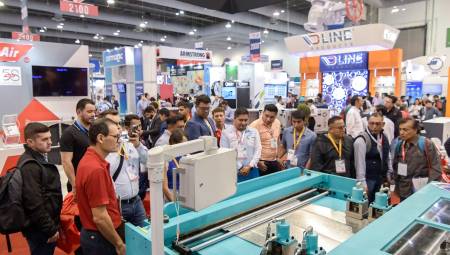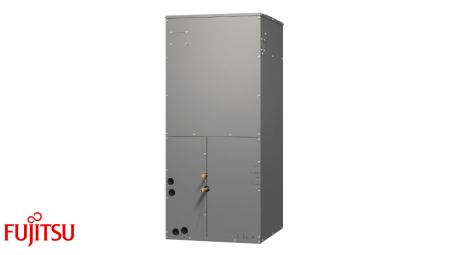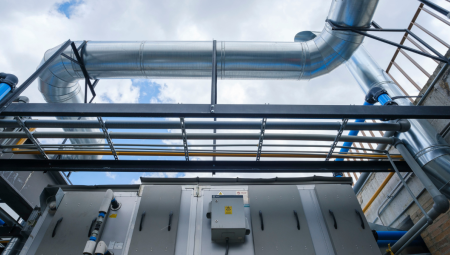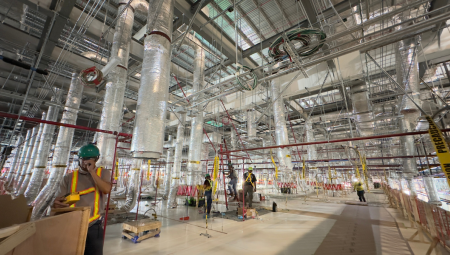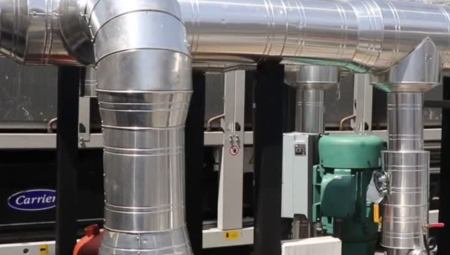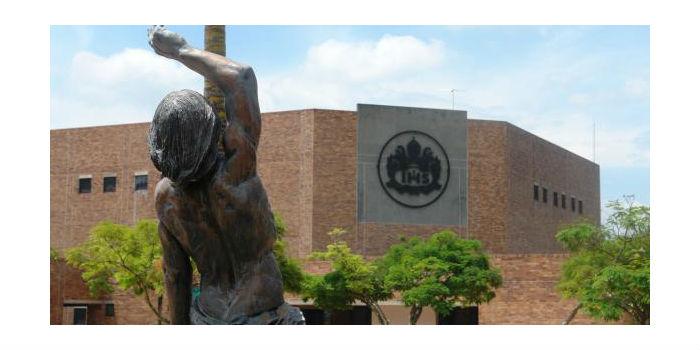 Evaluation and analysis of the air conditioning systems of the "Centro Técnico, Palmas y Almendros" of the Pontificia Universidad Javeriana de Cali, Colombia.
Evaluation and analysis of the air conditioning systems of the "Centro Técnico, Palmas y Almendros" of the Pontificia Universidad Javeriana de Cali, Colombia.
by Camilo Botero*
In the first part of this article, presented in the previous edition, the theoretical definitions that were taken into account for the project were broken down. The second part will talk about the project as such, from the systems that were found to the renovations and the consolidated cooling district.
Current system: The air conditioning system of the PUJ is basically composed of three major central systems, there are some smaller cold water and direct expansion, as will appear in this report. These larger systems are installed and distributed as follows:
- Technical Center System: 225 TR
- Palmas System: 344 TR
- Almond System: 244 TR
From the Central System of cold water Technical Center, there is currently a chiller condensed by water brand YORK, model HRF6709115, of the series CHOBTBR1143E1143975 of 225 TR, a cooling tower brand REYMSA, model 2LMD100-250, of the series 212-C0-120, with their respective pumps, as a very notorious fact, it can be seen that the piping systems are complex in the engine room, and also has good space for the location of a second and third chiller, as it appears in the project of the cold district of 2011. The current system that has only one chiller, is too vulnerable.
The total nominal installed capacity of this system is 225TR with a demand for equipment of the order of 560 TR, current.
From the Palmas Central Cold Water System, it currently has two YORK brand water condensed chillers, model YSBB BB S1-CG, of the SEJM-964060 series and SFJM-032590 of 172 TR each for a total of 344 TR, two AFC brand cooling towers, model TPA 200, of the 54919 and 55019 series with capacity for 200 TR each, with their respective pumps.
The total nominal installed capacity of this system is 344TR with a demand for equipment of the order of 714 TR, current.
From the Central Cold Water System Almendros, it currently has two york brand water condensed chillers, model YCWS0140, of the RLMM006776 series and RLMM006775 of 122 TR each for a total of 244 TR, two cooling towers AFC brand, model TAF 150, of the 709 and 55019 series with capacity for 140 TR each, with their respective pumps.
The total nominal installed capacity of this system is 244TR with a demand for equipment of the order of 663 TR, current.
Based on the information received previously and the tours carried out on campus during different visits, the nominal loads installed in the areas until the first report were verified, in order to compare them with the value of the three largest central cold water systems.
Factors of simultaneity with the nominal values for the current situation:
According to the nominal values described above, it can be concluded that the Pontificia Universidad Javeriana (PUJ) has a simultaneity factor in each of its major systems, of the following order:
- Technical Center System: 0.40
- Palm System: 0.46
- Almond System: 0.40
Because the value of the nominal load and the demand load with respect to the installed capacity in each of the central air conditioning systems (Technical Center, Palms and Almond Trees) are of the order as described below in the following table with their respective simultaneity factor, it can be said that this system in its general form has a nominal installed capacity vs demand factor, of the order of 40%.
If you take into account the loss of capacity of the systems which is a reality (see table below), the current demand is too high with respect to the installed capacity in your service, which makes the three systems vulnerable and deficient.

Table 1.
For reasons of university activity at present not all facilities are permanently occupied, there are areas such as auditoriums that are occupied sporadically. In the other areas, due to the characteristics of the academic activity, there are also appreciable variations in demand (occupied rooms, or not), but it is increasingly evident that it is necessary to repower cold water systems. In case of this being occupied at 100% load and taking into account the new climatic conditions, the system at full capacity could only really cover a third of the demand in the best of cases, which is why there are many inconveniences for the air conditioning of the areas. These days extreme weather (36°C) is recurrent, which has an impact on a greater demand for central cold water systems.
Conditions required for the areas of the Central System and climatic data, for the current design conditions, of Cali.

Table 2.
Note: All conditions are given for 1000 m (3250 Ft) height SNM
Evaluation conclusions
Below we will see the conclusions in the evaluation of the cold water systems in the PUJ, regarding the type of condensation and whether the new system would be fully centralized and / or repower the current systems.
Due to the characteristics of the central systems and their respective pipeline, a single central system is recommended, and repower the current systems improving the interconnection between them with a correctly designed pipe loop, but if having the highest cooling capacity in the Technical Center that will be developed in four stages.
After reviewing in detail the central cold water systems, it was decided that it is not possible with the current architecture of the machine zone to use new water condensation chillers with their respective cooling towers, which would theoretically give, more efficiency, but with an increase in the consumption of replacement water that is already very high today. With the technology available today, a Cooling District can be made with air condensation equipment with efficiencies similar to those of water condensation, in capacities up to 300 TR.
Decisions for a Cooling District
After performing the system reconnaissance and analyzing the information provided by the engineering staff, the surveys of the pipeline interconnection and the previous technical information of the equipment catalog and the analysis of said data, the following was previously concluded:
1. DetailEd Engineering was done for a state-of-the-art air condensation chiller in maximum capacity of 300 TR for the Almendros cold water system, which gives greater efficiency than the cold water systems currently installed; this would carry the burden for most of the time, with the current diversity factor; energy use will be improved and noise would be reduced, but puJ growth would not be addressed.
2. Because currently the installed systems are central cold water systems, constant speed condensation by water, and the improvement to more efficient chillers with variable speed compressors and air condensation, has a favorable return on investment, to pay for the project for energy savings; this requires information on current energy and water consumption, and their values. All interconnection pipe networks of current and future cold water systems were redesigned; the current ones are not adequate.
3. In accordance with the latest inventory of immediate and future medium-term future present loads, in relation to the upgrade of the central cold water and direct expansion (DX) systems on the PUJ campus, the following determinations were made; ratified in several meetings in Cali:
to. Make a Cooling District in the area of the current technical center with air condensation chillers, a total of 3 of 300 TR each and a water condensation chiller of 500 TR, with its corresponding cooling tower.
b. Leave the Palmas system with its original load by moving the load from the Guayacanes building to the Technical Center, which is feasible, given that there is a pipeline, from said Technical Center to Guayacanes.
c. Leave the original central cold water system of Almendros with its deficiency of one compressor less, taking into account the nominal load of the Almendros building (eventually academic record could be left due to its physical location).
d. All systems will be interconnected with a 12" pipe ring, with detailed engineering for STAGE I and in the process of elaboration for STAGES II, III and IV.
and. The electrical capacity of the current substation must be increased, which implies the design and construction of a new substation.
f. The topography of the land near the Cooling District must be studied to locate up to 3 chillers of 300 TR and a chiller of 500 TR of water condensation with its corresponding cooling tower as it appears and a civil works project for this. It is necessary to know the dimensions of the three cold water systems, since being interconnected these will interact their static pressures, of the different dimensions.
g. Suitable water expansion systems must be selected, to absorb volume variations, due to temperature change.
Simultaneity factor for Palmas removing Guayacanes.
1. Actual capacity of the 310 TR system and for a consumption of 391 TR will be 0.79, which is favorable
2. If a team of 13 TR DX is added to this, the simultaneity factor would be 0.76 which is also an acceptable value.
Simultaneity factor for Almond trees.
1. Actual capacity of the 165 TR system with three compressors since one is out of service, and for a consumption of 265 TR will be 0.62, acceptable value.
Consolidated Cooling District
Adding the current loads, medium-term cold water, immediate cold water, and conversion from DX to cold water give 3100 TR. Removing from this value the load that serves palms that is 391 TR and the one that attends Almendros 265 TR the consumption is 1290 TR, as there is already a chiller with a real capacity of 203 TR has an additional load present and future for the technical center of 1087 TR
According to the above analysis, it is presented as a favorable and convenient technical-economic option for the PUJ to acquire three chillers, of air condensation of last generation with variable compressor and of a size of 300 TR. and a Chiller of 500 TR, condensation by water.
* Camilo Botero is the current Secretary of the Federation of Ibero-American Associations of Air Conditioning and Refrigeration - FAIAR; he was president of ACAIRE and is president of Camilo Botero Ingenieros Consultores Ltda. He has worked as a teacher in several Colombian universities, guilds and currently in ACAIRE in diploma courses of air conditioning projects, energy efficiency in air conditioning and refrigeration, cogeneration and trigeneration, applied psychometrics, thermodynamics, fluid mechanics, heat transfer and turbomachinery. ([email protected]).








